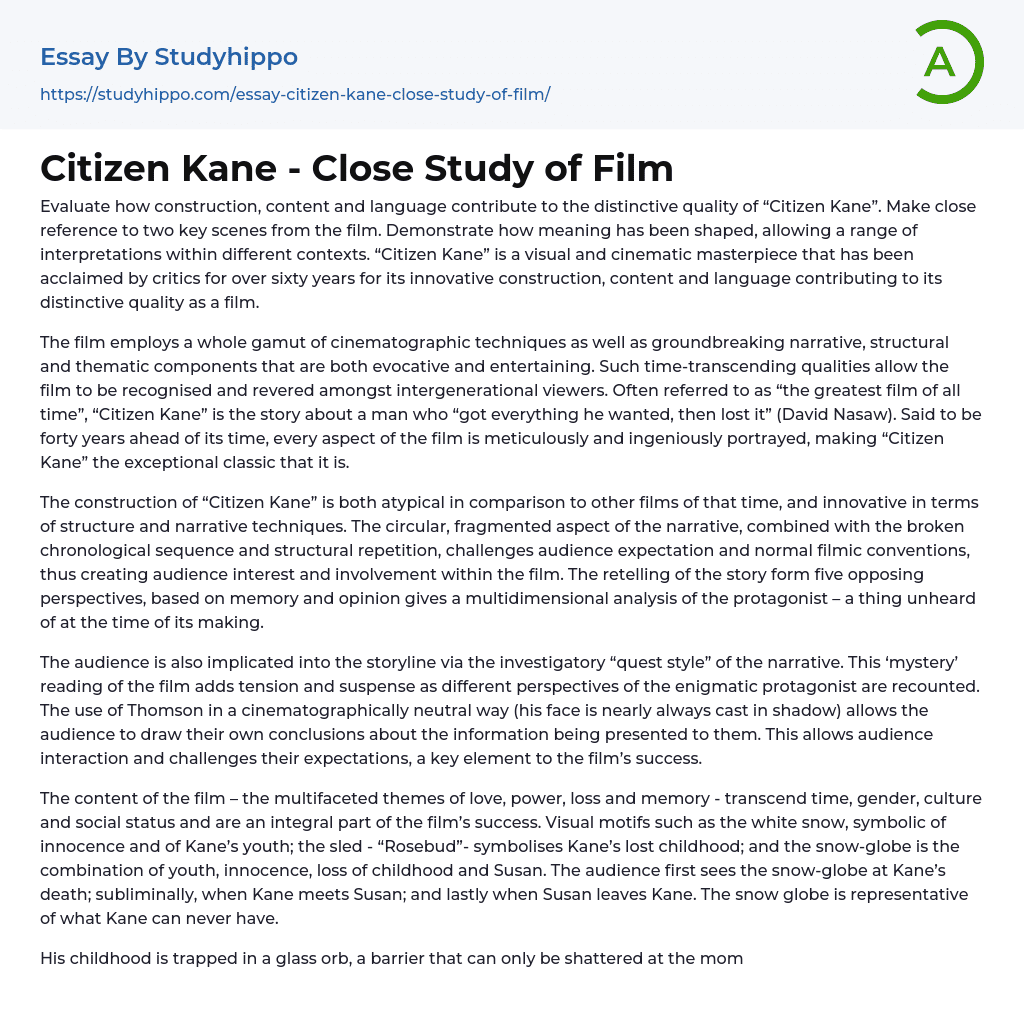The analysis of "Citizen Kane" centers on its structure, subject matter, and dialogue in two key scenes to comprehend its distinct qualities. This examination reveals how the film's significance has been molded to suit diverse interpretations in various circumstances. Throughout more than sixty years, reviewers have lauded "Citizen Kane" as an exceptional illustration of visual and cinematic artistry because of its pioneering construction, content, and language—all of which contribute to its uniqueness as a movie.
The movie "Citizen Kane" is esteemed and praised for its utilization of diverse cinematographic techniques, inventive elements in storytelling, organization, and subjects. These attributes render it stimulating and enjoyable for viewers spanning across different generations. David Nasaw regards this film as one of the most outstanding ever produced. It depicts the tale of an individual who attains all his aspirations but ultimately forfeits everything. Despite being four
...decades ahead of its era, every facet of "Citizen Kane" is meticulously depicted with resourcefulness, rendering it an exceptional masterpiece.
"Citizen Kane" is notable for its distinctive structure, narrative techniques, and innovative elements. The film's circular and fragmented narrative, non-linear timeline, and repeated structures defy traditional filmmaking norms, thus challenging viewer expectations. This unconventional approach ultimately captivates and fascinates the audience. Furthermore, the story is presented from five different viewpoints, offering a distinct examination of the main character through recollection and personal judgment. These aspects were groundbreaking during the production of "Citizen Kane."
The film engages the audience in a quest-like investigation, creating tension and suspense as various perspectives on the enigmatic protagonist unfold. By presenting Thomson's face mostly in shadow, the cinematography remains impartial, enabling viewers to
interpret the information they receive. This prompts audience interaction and defies their expectations, ultimately contributing to the film's success.
The film delves into enduring and universal themes, such as love, power, loss, and memory. These themes transcend time, gender, culture, and social status. Additionally, the film incorporates various visual symbols that contribute to its success. For instance, the white snow signifies innocence and Kane's youth. Furthermore, the sled named "Rosebud" symbolizes Kane's lost childhood. The snow-globe represents elements of youthfulness, innocence, the loss of childhood, and Susan. Initially appearing during Kane's death scene and later reappearing when he encounters Susan before her departure. Ultimately, the snow-globe serves as a symbol of something beyond Kane's reach.
Kane's childhood is like a glass sphere that cannot be broken until his death, making it impossible to access. It is the only thing he can never regain and will always be lost. The snow globe symbolizes loss and love, emphasizing his yearning for affection. Psychoanalysts believe that Kane's separation from his mother at an early age hindered his ability to form lasting relationships due to a lack of "transference." By destroying Susan's room, Kane reveals his emotional vulnerability and expresses the pain of losing the one thing he cherishes, using the only means available to him.
The symbol "K" represents his arrogance and desire for control, resulting in his corruption. Additionally, the theme of memory is connected to the stories told by those closest to him and the mystery of "Rosebud." This emphasizes that memory is subjective and fragmented, often unreliable and biased. Furthermore, these universal themes of love, memory, loss, and power allow people from
different social backgrounds to interpret the movie in diverse ways.
Kane's desire for power leads to his self-corruption, which is prominently depicted in the Breakfast Table montage. This sequence is considered one of the most evocative parts of the film, as it showcases innovative cinematography, lighting, dialogue, and staging. Lasting two minutes, the montage illustrates the deterioration of Kane's marriage and demonstrates Welles' creativity and experimentation as a director, as well as the extensive editing involved.
- Accident essays
- Awareness essays
- Benefits of Volunteering essays
- Challenges essays
- Childhood Memories essays
- Decision essays
- Driving essays
- Event essays
- Excellence essays
- Expectations essays
- Failure essays
- Farewell essays
- Flight essays
- Gift essays
- Growing Up essays
- Ignorance essays
- Improve essays
- Incident essays
- Knowledge essays
- Luck essays
- Memories essays
- Mistake essays
- Obstacles essays
- Overcoming Challenges essays
- Party essays
- Peace Corps essays
- Personal Experience essays
- Problems essays
- Sacrifices essays
- Struggle essays
- Success essays
- Trust essays
- Vacation essays
- Visit essays
- Volunteering essays
- John Locke essays
- 9/11 essays
- A Good Teacher essays
- A Healthy Diet essays
- A Modest Proposal essays
- A&P essays
- Academic Achievement essays
- Achievement essays
- Achieving goals essays
- Admission essays
- Advantages And Disadvantages Of Internet essays
- Alcoholic drinks essays
- Ammonia essays
- Analytical essays
- Ancient Olympic Games essays




